Effect of Al2O3–SiO2 Addition on Gehlenite Growth and the Mechanical Performance of Steel Slag
Abstract
:1. Introduction
2. Experiment
2.1. Raw Material Analysis
2.2. Thermodynamics
2.3. Calculate Ingredients
- By calculation, m1:m(Al2O3):m(SiO2) = 4.8:2:1;
- Among them: m1 is the quantity ratio of steel slag;
- m(Al2O3) is the quantity ratio of Al2O3;
- m(SiO2) is the quantity ratio of SiO2;
- θ(CaO) is the mass fraction of CaO in steel slag;
- θ(SiO2) is the mass fraction of SiO2 in the steel slag.
2.4. Sample Preparation
2.5. Sintering System
3. Results and Analysis
3.1. Phase Analysis
3.2. Microstructure Analysis
3.3. Mechanical Performance Analysis
4. Conclusions
- After the Al2O3–SiO2 system is added to the steel slag for modification, gehlenite crystals are formed at high temperatures, and its compressive strength is also be significantly enhanced.
- Gehlenite crystals are formed at 1200 °C, and the size gradually increases as the temperature rises; meanwhile, the sample becomes denser. When the sintering temperature increases to 1360 °C, the sample appears to melt, which is caused by over burning.
- The compressive strength of modified steel slag is much greater than that of steel slag. There is a great correlation between the growth of gehlenite and the compressive strength of the modified steel slag. The more gehlenite grows, the higher compressive strength achieves. The optimal temperature is 1350 °C and the compressive strength is 115 MPa.
Author Contributions
Funding
Institutional Review Board Statement
Informed Consent Statement
Data Availability Statement
Acknowledgments
Conflicts of Interest
References
- Rupinder, S.; Harpreet, S.; Ilenia, F.; Francesco, C.; Fernando, F. On the additive manufacturing of an energy storage device from recycled materials. Compos. B Eng. 2018, 156, 259–265. [Google Scholar]
- Parron, R.M.; Perez, G.F.; Gonzalez, H.A.; Rubio, C. Concrete Properties Comparison When Substituting a 25% Cement with Slag from Different Provenances. Materials 2018, 11, 1029. [Google Scholar] [CrossRef] [Green Version]
- Yi, H.; Xu, G.P.; Cheng, H.G.; Wang, J.S.; Wan, Y.F.; Chen, H. An Overview of Utilization of Steel Slag. Procedia Environ. Sci. 2012, 16, 791–801. [Google Scholar] [CrossRef] [Green Version]
- Zhang, G. Status of Comprehensive utilization of steel slag at Baosteel. Baosteel Technol. 2006, 1, 20–24. [Google Scholar]
- Pallabi, D.; Sidhidatri, U.; Sudarshan, D.; Krishnakant, K.S. Waste to wealth: Recovery of value-added products from steel slag. J. Environ. Chem. Eng. 2021, 9, 105640. [Google Scholar]
- Krzaklewski, W.; Jamrozik, A.; Fijał, J.; Gonet, A.; Czekaj, L. Evaluation of the Suitability of the Transformed Drilling Waste for Land Reclamation. In Proceedings of the 17th International Multidisciplinary Scientific Geo Conference, SGEM2017, Vienna, Austria, 27–29 November 2017; Volume 1.5, pp. 163–170. [Google Scholar]
- Dhoble, Y.N.; Ahmed, S. Review on the innovative uses of steel slag for waste minimization. J. Mater. Cycles Waste Manag. 2018, 20, 1–10. [Google Scholar] [CrossRef]
- Yan, Z.P.; Shu, G.H.; Qing, J.D. Preparation of reactive powder concrete using fly ash and steel slag powder. J. Wuhan Univ. Technol. Mater. Sci. Ed. 2010, 25, 349–354. [Google Scholar]
- Wang, X.; Ni, W.; Li, J.; Zhang, S.Q.; Hitch, M.; Pascual, R. Carbonation of steel slag and gypsum for building materials and associated reaction mechanisms. Cem. Concr. Res. 2019, 125, 105893. [Google Scholar] [CrossRef]
- Liao, Y.S.; Jiang, G.X.; Wang, K.J.; Siraj, A.Q.; Yuan, W.J. Effect of steel slag on the hydration and strength development of calcium sulfoaluminate cement. Constr. Build. Mater. 2020, 265, 120301. [Google Scholar] [CrossRef]
- Chompoorat, T.; Thepumong, T.; Nuaklong, P.; Jongvivatsakul, P. Alkali-Activated Controlled Low-Strength Material Utilizing High-Calcium Fly Ash and Steel Slag for Use as Pavement Materials. J. Mater. Civ. Eng. 2021, 33, 04021178. [Google Scholar] [CrossRef]
- Marco, P.; Andrea, B.; Emiliano, P.; Marta, S.; Vanesa, O.L. Performance-Based Characterization of Bituminous Mortars Prepared With Ladle Furnace Steel Slag. Sustainability 2020, 12, 1777. [Google Scholar]
- Jattak, Z.A.; Hassan, N.A.; Shukry, N.A.M.; Satar, M.K.I.M.; Warid, M.N.M.; Nor, H.M.; Yunus, N.Z.M. Characterization of industrial by-products as asphalt paving material. IOP Conf. Ser. Earth Environ. Sci. 2019, 220, 012012. [Google Scholar] [CrossRef]
- He, M.; Li, B.; Zhou, W.; Chen, H.S.; Liu, M.; Zou, L. Preparation and Characteristics of Steel Slag Ceramics from Converter Slag. In TMS Annual Meeting and Exhibition; Springer: Cham, Switzerland, 2018; pp. 13–20. [Google Scholar]
- Tang, Z.J.; Liang, J.; Jiang, W.H.; Liu, J.M.; Jiang, F.; Feng, G.; Lao, X.B.; Tang, H.D.; Wang, T. Preparation of high strength foam ceramics from sand shale and steel slag. Ceram. Int. 2020, 46, 9256–9262. [Google Scholar] [CrossRef]
- Zong, Y.B.; Wan, Q.; Cang, D.Q. Preparation of anorthite-based porous ceramics using high-alumina fly ash microbeads and steel slag. Ceram. Int. 2019, 45, 22445–22451. [Google Scholar] [CrossRef]
- Mymrin, V.; Guidolin, M.A.; Klitzke, W.; Alekseev, K.; Guidolin, R.H.; Avanci, M.A.; Pawlowsky, U.E.W., Jr.; Cataia, R.E. Environmentally clean ceramics from printed circuit board sludge, red mud of bauxite treatment and steel slag. J. Clean. Prod. 2017, 164, 831–839. [Google Scholar] [CrossRef]
- Luo, Z.H.; He, F.; Zhang, W.T.; Xiao, Y.L.; Xie, Y.L.; Sun, R.J.; Xie, M.Q. Effects of fluoride content on structure and properties of steel slag glass-ceramics. Mater. Chem. Phys. 2020, 242, 122531. [Google Scholar] [CrossRef]
- Li, Y.; Zhao, L.H.; Wang, Y.K.; Cang, D.Q. Effects of Fe2O3 on the properties of ceramics from steel slag. Int. J. Min. Met. Mater. 2018, 25, 413–419. [Google Scholar] [CrossRef]
- Tabit, K.; Hajjou, H.; Waqif, M.; Saâdi, L. Effect of CaO/SiO2 ratio on phase transformation and properties of anorthite-based ceramics from coal fly ash and steel slag. Ceram. Int. 2020, 46, 7550–7558. [Google Scholar] [CrossRef]
- Deng, L.; Yun, F.; Jia, R.D.; Li, H.; Jia, X.; Shi, Y.; Zhang, X.F. Effect of SiO2/MgO ratio on the crystallization behavior, structure, and properties of wollastonite-augite glass-ceramics derived from stainless steel slag. Mater. Chem. Phys. 2020, 239, 122039. [Google Scholar] [CrossRef]
- Zhang, X.; Zheng, C.; Liu, S.; Zong, Y.; Qin, S. Preparation of Steel Slag Ceramics with Different MgO/Al2O3 Ratios. Appl. Sci. 2019, 9, 4741. [Google Scholar] [CrossRef] [Green Version]
- Zhang, Y.; Guo, Z.H.; Wang, S.; Xiao, X.Y.; Han, Z.Y.; Huang, B.; Nie, Y.F. Sintering fabrication of gehlenite/magnesia-alumina spinel composites by secondary aluminum dross. Chin. J. Nonferrous Met. 2018, 2, 128–133. [Google Scholar]
- Feng, Q.L.; Cui, F.Z.; Pu, G.; Wang, R.Z.; Li, H.D. Crystal orientation, toughening mechanisms and a mimic of nacre. Mater. Sci. Eng. C 2000, 11, 19–25. [Google Scholar] [CrossRef]
- Li, Y.; Wei, Q.H.; Li, L.; Wang, C.H.; Zhang, X.L.; Gao, F. Effects of Heat-Treatment Temperature on the Properties of Negative CTE Eucryptite Ceramics. Adv. Mat. Res. 2010, 105, 123–125. [Google Scholar] [CrossRef]
- Pan, X.L.; Zhang, D.; Wu, Y.; Yu, H.Y. Synthesis and characterization of calcium aluminate compounds from gehlenite by high-temperature solid-state reaction. Ceram. Int. 2018, 44, 13544–13550. [Google Scholar] [CrossRef]
- Zhang, S.X.; Zhu, Y.P.; Cai, G.Y. Influence of Over burning on Microstructure and Property of 2024 Aluminum Alloy. Adv. Mat. Res. 2014, 941, 3–7. [Google Scholar]
- Kamal, T.; Mohamed, W.; Latifa, S. Anorthite-cordierite based binary ceramics from coal fly ash and steel slag for thermal and dielectric applications. Mater. Chem. Phys. 2020, 254, 123472. [Google Scholar]
- Huang, Q.; Liu, T.; Zhang, J.S.; He, X.; Liu, J.L.; Luo, Z.W.; Lu, A. Properties and pore-forming mechanism of silica sand tailing-steel slag-coal gangue based permeable ceramics. Comstr. Build. Mater. 2020, 253, 118870. [Google Scholar] [CrossRef]
- Lim, Y.C.; Lin, S.K.; Ju, Y.R.; Wu, C.H.; Lin, Y.L.; Chen, C.W.; Dong, C.D. Reutilization of dredged harbor sediment and steel slag by sintering as lightweight aggregate. Process Saf. Environ. 2019, 126, 287–296. [Google Scholar] [CrossRef]
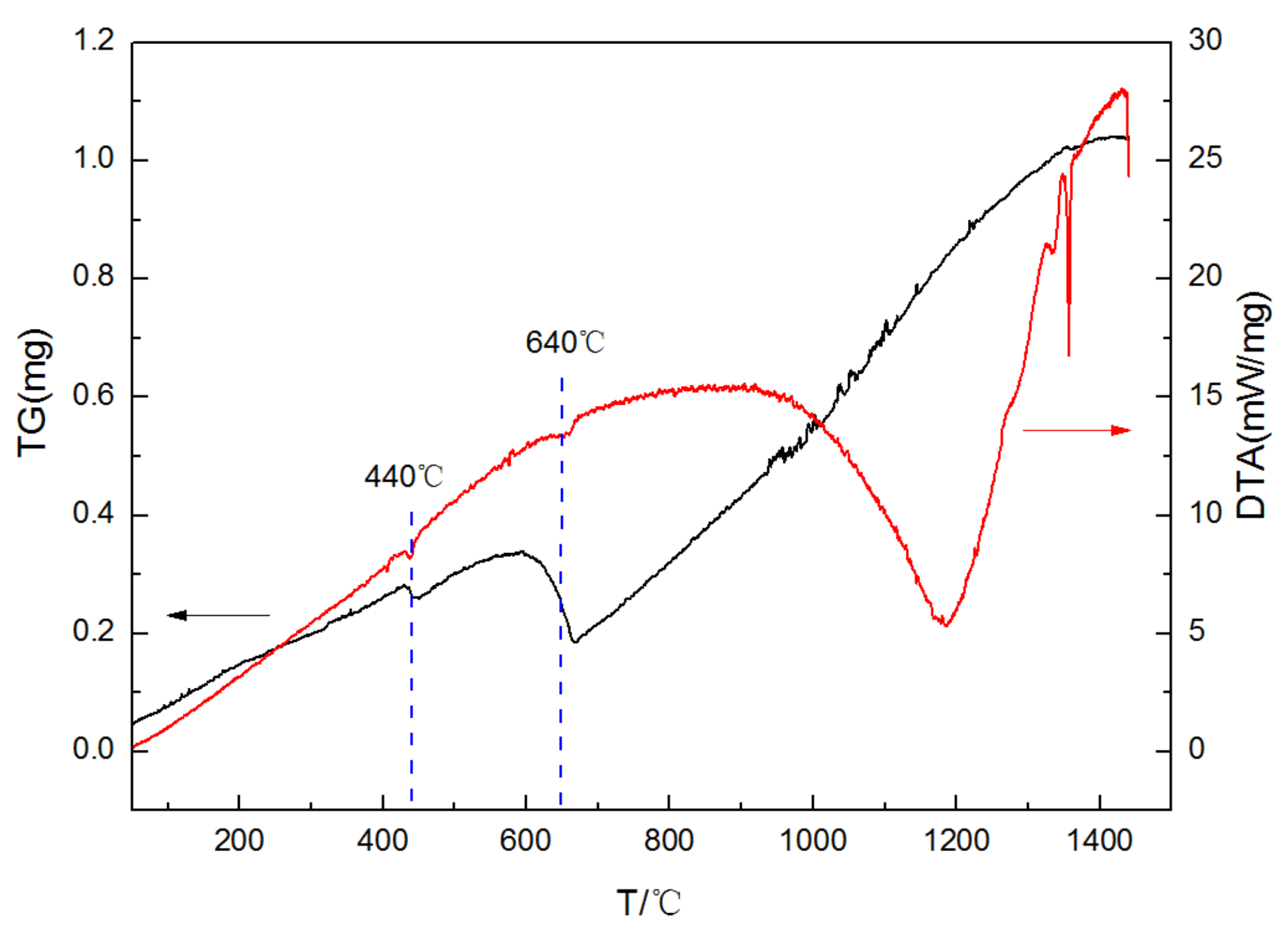
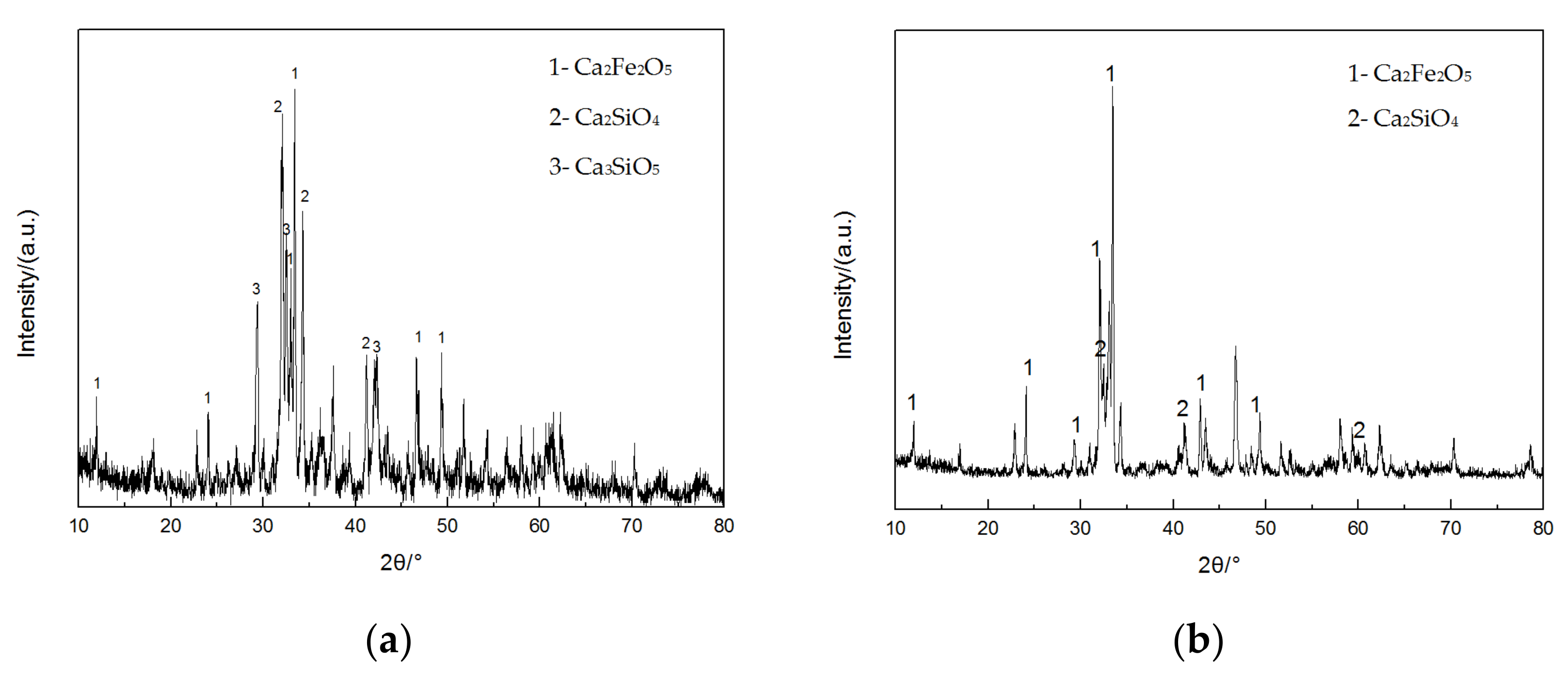
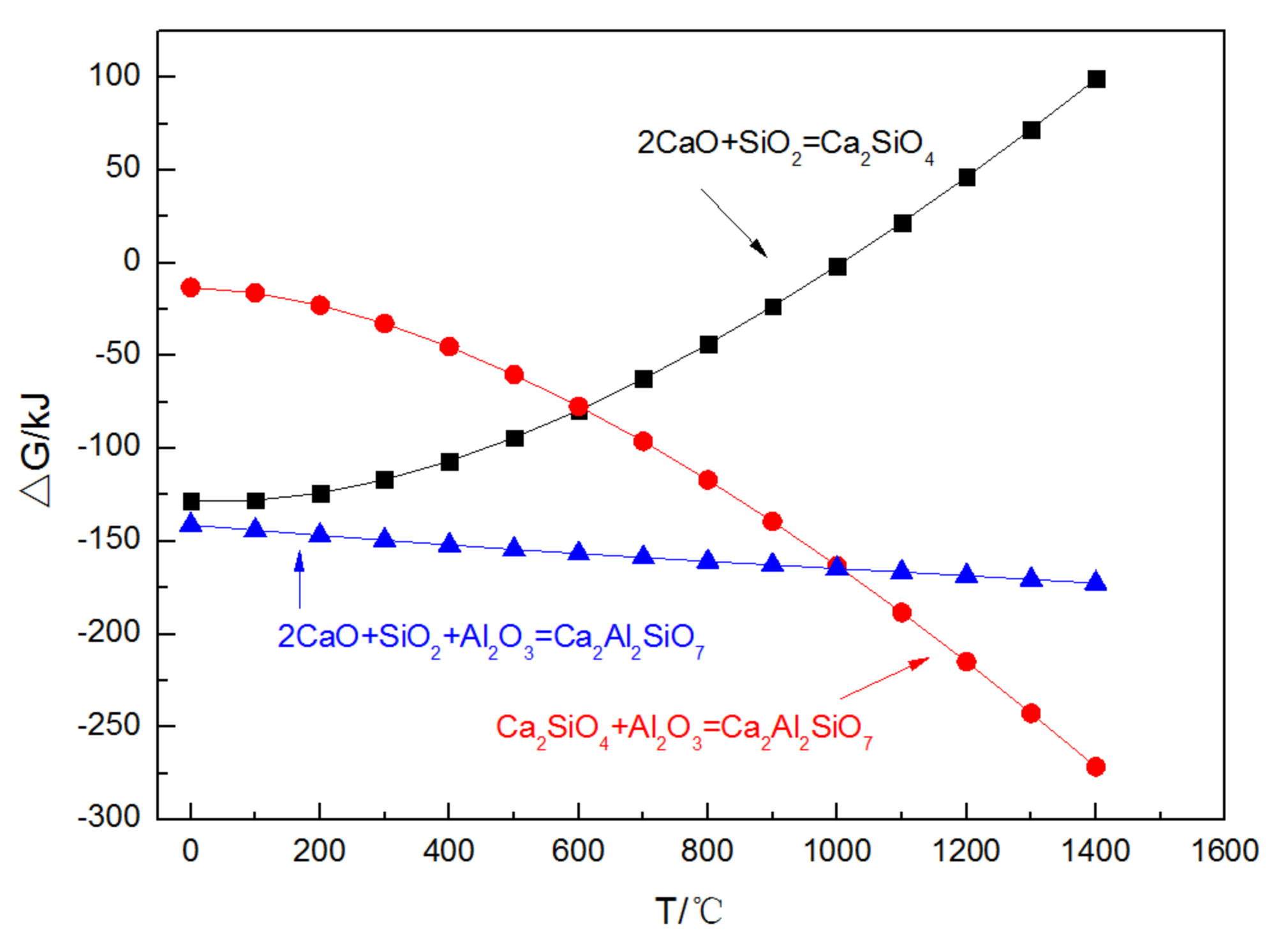

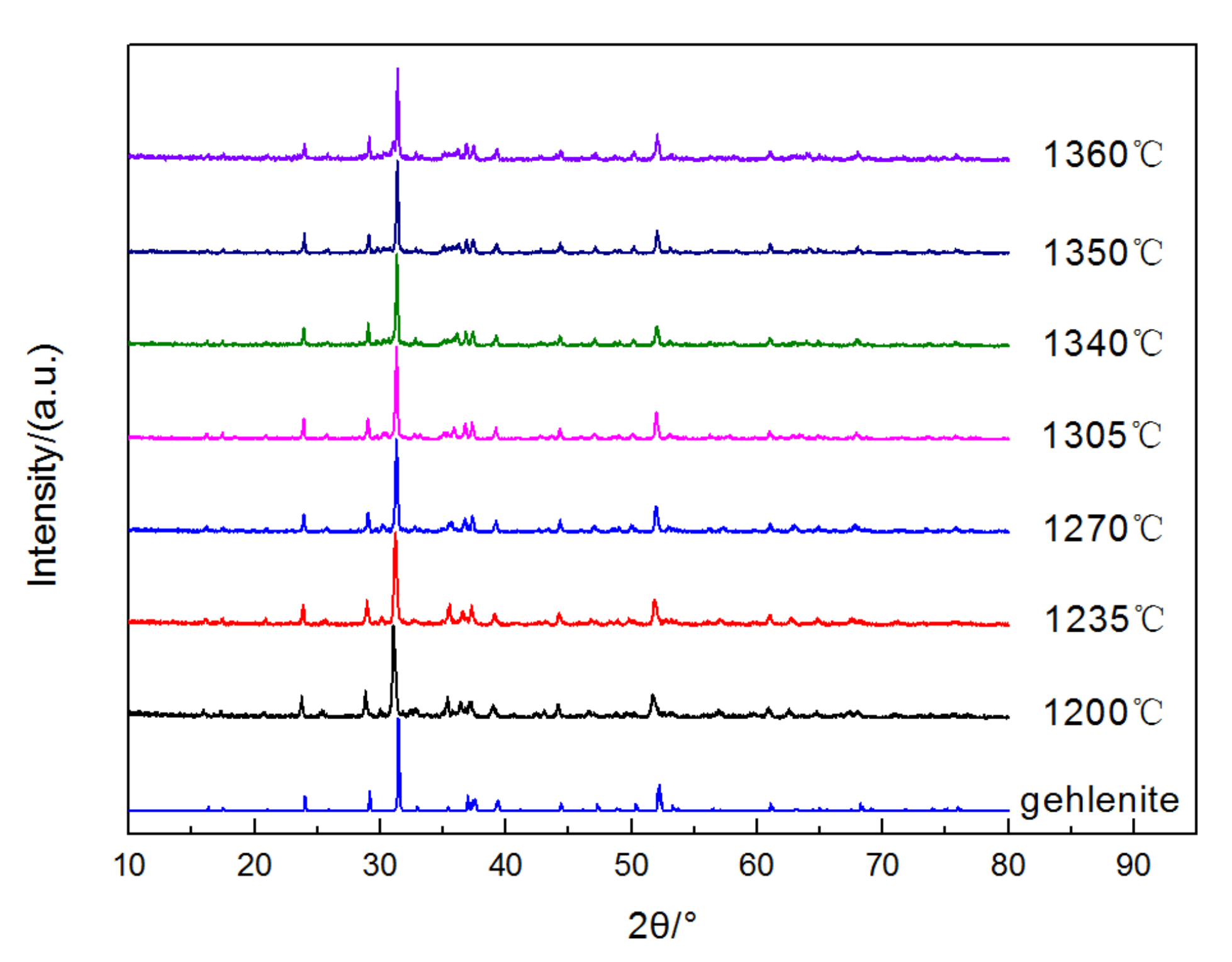

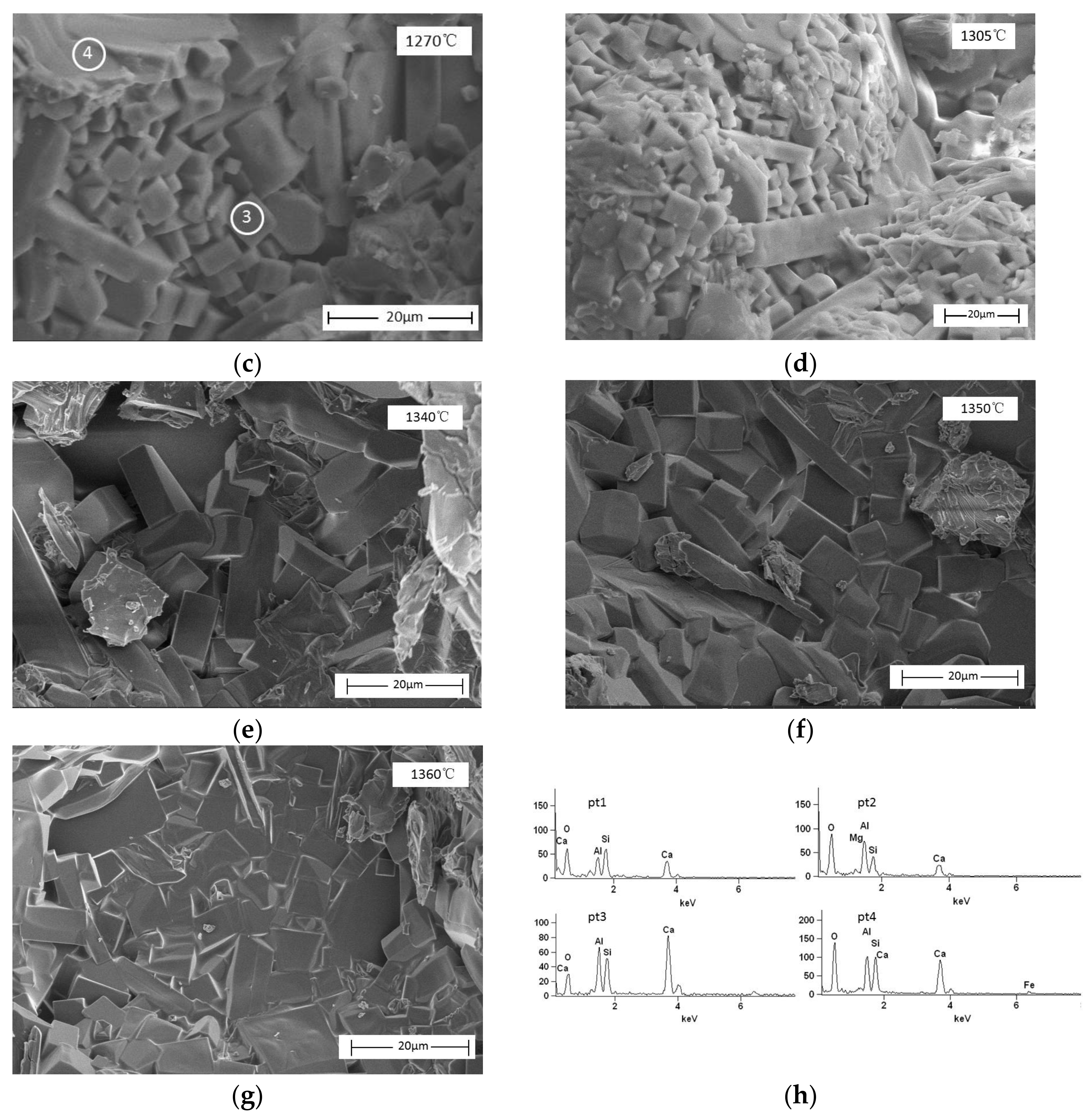
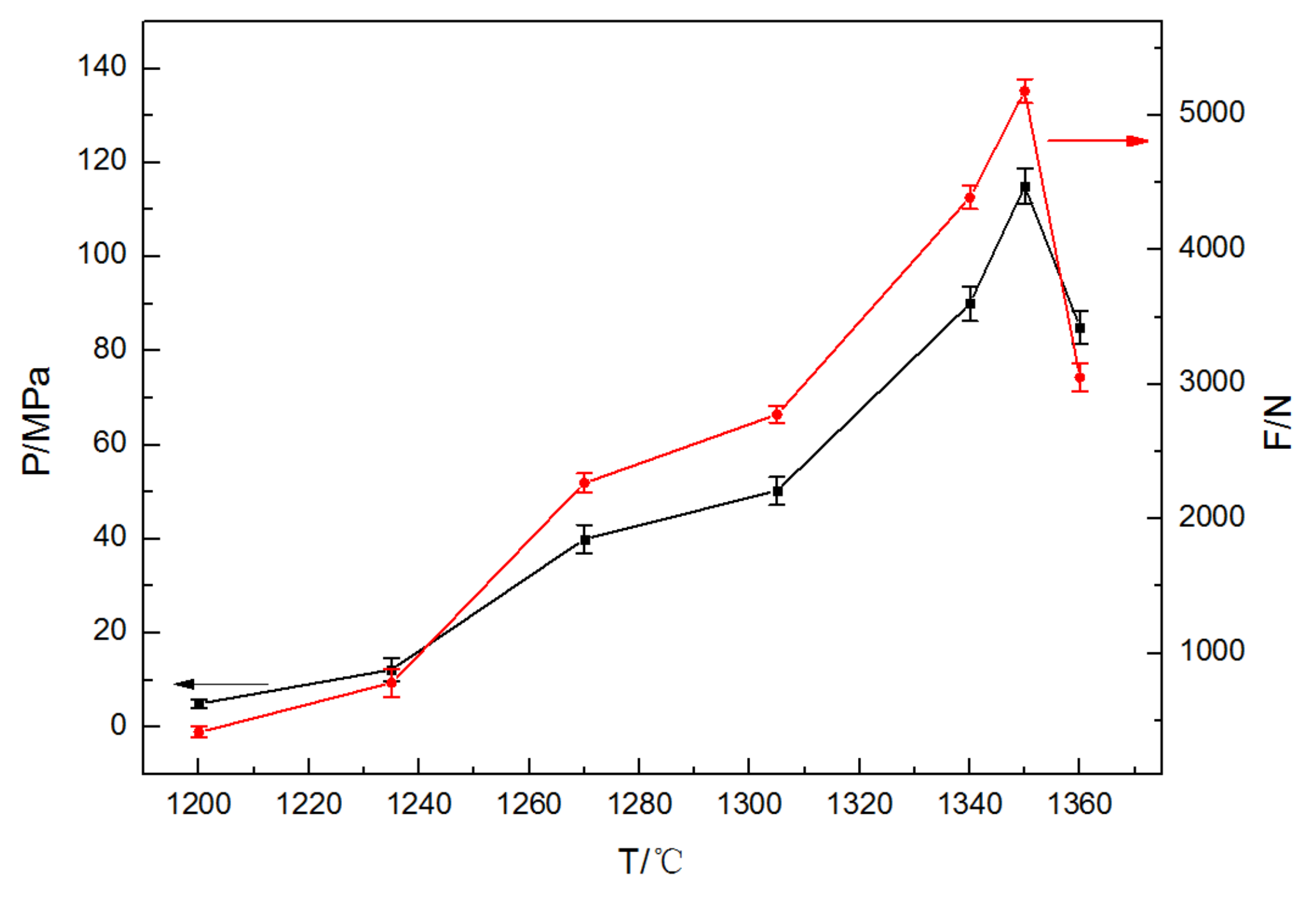
| Element | Ca | Fe | Si | Mn | Mg | Al | P | V | Ti | Cr |
|---|---|---|---|---|---|---|---|---|---|---|
| proportion/% | 51.87 | 32.09 | 7.67 | 2.65 | 2.39 | 0.87 | 0.76 | 0.65 | 0.58 | 0.15 |
| No. | Raw Material | Sintering Temperature | Main Phase | Compressive Strength | Suggested Application | Refs. |
|---|---|---|---|---|---|---|
| 1 | Steel slag Coal fly ash | 1188 °C | Anorthite | 41 MPa | Anorthite-based ceramics | [20] |
| 2 | Steel slag Coal fly ash Cordierite Precursor | 1200 °C | α-cordierite | 80 MPa | Clean glass-ceramics | [28] |
| 3 | Silica sand Tailing Steel slag Coal gangue | 1150–1170 °C | Hematite Magnetite | 72.39 MPa | Permeable ceramics | [29] |
| 4 | Harbor sediment Steel slag | 1175 °C | Glass phase | 23.2 MPa | Lightweight aggregates | [30] |
| Samples | Steel slag Alumina Silica | 1350 °C | Gehlenite | 115 MPa | Ceramics | - |
Publisher’s Note: MDPI stays neutral with regard to jurisdictional claims in published maps and institutional affiliations. |
© 2021 by the authors. Licensee MDPI, Basel, Switzerland. This article is an open access article distributed under the terms and conditions of the Creative Commons Attribution (CC BY) license (https://creativecommons.org/licenses/by/4.0/).
Share and Cite
Xu, Y.; Song, P.; Cao, W.; Li, H.; Liang, J. Effect of Al2O3–SiO2 Addition on Gehlenite Growth and the Mechanical Performance of Steel Slag. Crystals 2021, 11, 936. https://doi.org/10.3390/cryst11080936
Xu Y, Song P, Cao W, Li H, Liang J. Effect of Al2O3–SiO2 Addition on Gehlenite Growth and the Mechanical Performance of Steel Slag. Crystals. 2021; 11(8):936. https://doi.org/10.3390/cryst11080936
Chicago/Turabian StyleXu, Ying, Pan Song, Weigang Cao, Hui Li, and Jinglong Liang. 2021. "Effect of Al2O3–SiO2 Addition on Gehlenite Growth and the Mechanical Performance of Steel Slag" Crystals 11, no. 8: 936. https://doi.org/10.3390/cryst11080936






